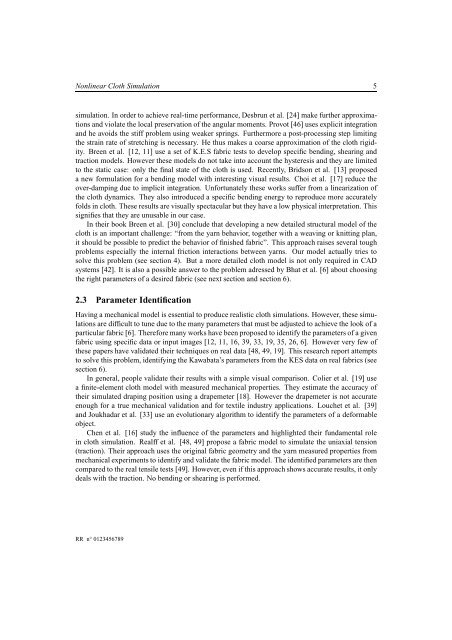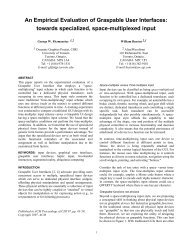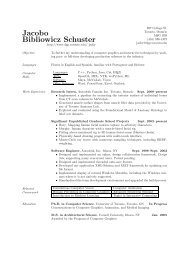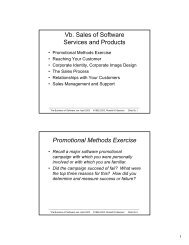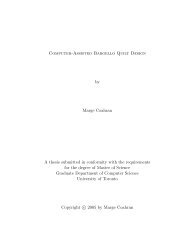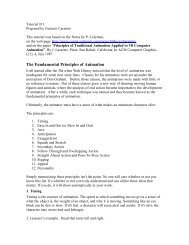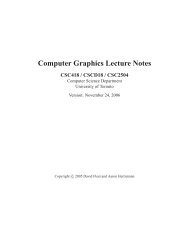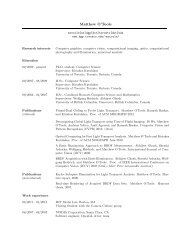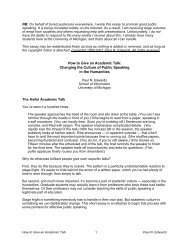Nonlinear Cloth Simulation - dgp
Nonlinear Cloth Simulation - dgp
Nonlinear Cloth Simulation - dgp
You also want an ePaper? Increase the reach of your titles
YUMPU automatically turns print PDFs into web optimized ePapers that Google loves.
<strong>Nonlinear</strong> <strong>Cloth</strong> <strong>Simulation</strong> 5<br />
simulation. In order to achieve real-time performance, Desbrun et al. [24] make further approximations<br />
and violate the local preservation of the angular moments. Provot [46] uses explicit integration<br />
and he avoids the stiff problem using weaker springs. Furthermore a post-processing step limiting<br />
the strain rate of stretching is necessary. He thus makes a coarse approximation of the cloth rigidity.<br />
Breen et al. [12, 11] use a set of K.E.S fabric tests to develop specific bending, shearing and<br />
traction models. However these models do not take into account the hysteresis and they are limited<br />
to the static case: only the final state of the cloth is used. Recently, Bridson et al. [13] proposed<br />
a new formulation for a bending model with interesting visual results. Choi et al. [17] reduce the<br />
over-damping due to implicit integration. Unfortunately these works suffer from a linearization of<br />
the cloth dynamics. They also introduced a specific bending energy to reproduce more accurately<br />
folds in cloth. These results are visually spectacular but they have a low physical interpretation. This<br />
signifies that they are unusable in our case.<br />
In their book Breen et al. [30] conclude that developing a new detailed structural model of the<br />
cloth is an important challenge: “from the yarn behavior, together with a weaving or knitting plan,<br />
it should be possible to predict the behavior of finished fabric”. This approach raises several tough<br />
problems especially the internal friction interactions between yarns. Our model actually tries to<br />
solve this problem (see section 4). But a more detailed cloth model is not only required in CAD<br />
systems [42]. It is also a possible answer to the problem adressed by Bhat et al. [6] about choosing<br />
the right parameters of a desired fabric (see next section and section 6).<br />
2.3 Parameter Identification<br />
Having a mechanical model is essential to produce realistic cloth simulations. However, these simulations<br />
are difficult to tune due to the many parameters that must be adjusted to achieve the look of a<br />
particular fabric [6]. Therefore many works have been proposed to identify the parameters of a given<br />
fabric using specific data or input images [12, 11, 16, 39, 33, 19, 35, 26, 6]. However very few of<br />
these papers have validated their techniques on real data [48, 49, 19]. This research report attempts<br />
to solve this problem, identifying the Kawabata’s parameters from the KES data on real fabrics (see<br />
section 6).<br />
In general, people validate their results with a simple visual comparison. Colier et al. [19] use<br />
a finite-element cloth model with measured mechanical properties. They estimate the accuracy of<br />
their simulated draping position using a drapemeter [18]. However the drapemeter is not accurate<br />
enough for a true mechanical validation and for textile industry applications. Louchet et al. [39]<br />
and Joukhadar et al. [33] use an evolutionary algorithm to identify the parameters of a deformable<br />
object.<br />
Chen et al. [16] study the influence of the parameters and highlighted their fundamental role<br />
in cloth simulation. Realff et al. [48, 49] propose a fabric model to simulate the uniaxial tension<br />
(traction). Their approach uses the original fabric geometry and the yarn measured properties from<br />
mechanical experiments to identify and validate the fabric model. The identified parameters are then<br />
compared to the real tensile tests [49]. However, even if this approach shows accurate results, it only<br />
deals with the traction. No bending or shearing is performed.<br />
RR n° 0123456789


